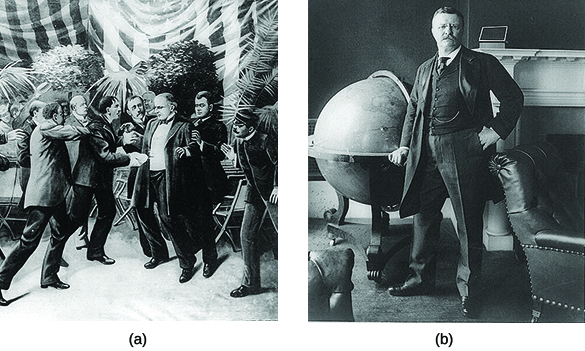| << Chapter < Page | Chapter >> Page > |
Progressive groups made tremendous strides on issues involving democracy, efficiency, and social justice. But they found that their grassroots approach was ill-equipped to push back against the most powerful beneficiaries of growing inequality, economic concentration, and corruption—big business. In their fight against the trusts, Progressives needed the leadership of the federal government, and they found it in Theodore Roosevelt in 1901, through an accident of history.
In 1900, a sound economic recovery, a unifying victory in the Spanish-American War, and the annexation of the Philippines had helped President William McKinley secure his reelection with the first solid popular majority since 1872. His new vice president was former New York Governor and Assistant Secretary of the Navy, Theodore Roosevelt. But when an assassin shot and killed President McKinley in 1901 ( [link] ) at the Pan-American Exposition in Buffalo, New York, Theodore Roosevelt unexpectedly became the youngest president in the nation’s history. More importantly, it ushered in a new era of progressive national politics and changed the role of the presidency for the twentieth century.

Roosevelt’s early career showed him to be a dynamic leader with a Progressive agenda. Many Republican Party leaders disliked Roosevelt’s Progressive ideas and popular appeal and hoped to end his career with a nomination to the vice presidency—long considered a dead end in politics. When an assassin’s bullet toppled this scheme, Mark Hanna, a prominent Republican senator and party leader, lamented, “Now look! That damned cowboy is now president!”
As the new president, however, Roosevelt moved cautiously with his agenda while he finished out McKinley’s term. Roosevelt kept much of McKinley’s cabinet intact, and his initial message to Congress gave only one overriding Progressive goal for his presidency: to eliminate business trusts. In the three years prior to Roosevelt’s presidency, the nation had witnessed a wave of mergers and the creation of mega-corporations. To counter this trend, Roosevelt created the Department of Commerce and Labor in 1903, which included the Bureau of Corporations, whose job it was to investigate trusts. He also asked the Department of Justice to resume prosecutions under the Sherman Antitrust Act of 1890. Intended to empower federal prosecutors to ban monopolies as conspiracies against interstate trade, the law had run afoul of a conservative Supreme Court.
In 1902, Roosevelt launched his administration’s first antitrust suit against the Northern Securities Trust Company, which included powerful businessmen, like John D. Rockefeller and J. P. Morgan, and controlled many of the large midwestern railroads. The suit wound through the judicial system, all the way to the U.S. Supreme Court. In 1904, the highest court in the land ultimately affirmed the ruling to break up the trust in a narrow five-to-four vote. For Roosevelt, that was enough of a mandate; he immediately moved against other corporations as well, including the American Tobacco Company and—most significantly—Rockefeller’s Standard Oil Company.

Notification Switch
Would you like to follow the 'U.s. history' conversation and receive update notifications?